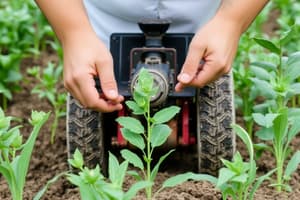Podcast
Questions and Answers
What is a key benefit of hands-on demonstrations in teaching agriculture and fisheries?
What is a key benefit of hands-on demonstrations in teaching agriculture and fisheries?
- Enhancing students' learning experience (correct)
- Increased use of abstract concepts
- Decrease in student engagement
- Limited development of problem-solving skills
How do students benefit from technology integration in agriculture and fisheries education?
How do students benefit from technology integration in agriculture and fisheries education?
- Isolation from practical applications
- Access to real-time data on crop yields or livestock health (correct)
- Decreased ability to model complex systems
- Reduction in problem-solving skills
Which teaching strategy can help foster a deeper understanding of practical applications in agriculture and fisheries?
Which teaching strategy can help foster a deeper understanding of practical applications in agriculture and fisheries?
- Passive learning activities
- Interactive workshops (correct)
- Rote memorization techniques
- Lecture-based instruction
What role do visual aids play in effective teaching of agriculture and fisheries?
What role do visual aids play in effective teaching of agriculture and fisheries?
How can interactive workshops contribute to students' learning experience in agriculture and fisheries education?
How can interactive workshops contribute to students' learning experience in agriculture and fisheries education?
Which method allows students to physically engage with abstract concepts in agriculture and fisheries teaching?
Which method allows students to physically engage with abstract concepts in agriculture and fisheries teaching?
Which of the following is an effective tool for exposing students to cutting-edge techniques in agriculture and fisheries?
Which of the following is an effective tool for exposing students to cutting-edge techniques in agriculture and fisheries?
What is the primary advantage of integrating technology in teaching agriculture and fisheries?
What is the primary advantage of integrating technology in teaching agriculture and fisheries?
Which of the following visual aids is most effective for illustrating biological processes in agriculture and fisheries?
Which of the following visual aids is most effective for illustrating biological processes in agriculture and fisheries?
What is the primary benefit of interactive workshops in teaching agriculture and fisheries?
What is the primary benefit of interactive workshops in teaching agriculture and fisheries?
Which of the following can instructors use to assess students' progress and identify areas for improvement in agriculture and fisheries education?
Which of the following can instructors use to assess students' progress and identify areas for improvement in agriculture and fisheries education?
What is the primary goal of combining practical experience with theoretical knowledge in teaching agriculture and fisheries?
What is the primary goal of combining practical experience with theoretical knowledge in teaching agriculture and fisheries?
Flashcards are hidden until you start studying
Study Notes
Teaching Agriculture and Fisheries: Demonstration Methods
Effective demonstration methods play a crucial role in teaching agriculture and fisheries. By incorporating hands-on demonstrations, technology integration, visual aids, and interactive workshops into their lessons, instructors can enhance students' learning experience and foster a deeper understanding of practical applications in the field. Here's a closer look at each of these strategies and their benefits.
Hands-on Demonstrations
Hands-on demonstrations allow students to physically engage with the subject matter, making abstract concepts more tangible. These demonstrations can involve direct manipulation of materials, such as soil sampling in agriculture or observing fish behavior in aquaculture. By actively participating, students develop problem-solving skills and gain confidence in their abilities, ultimately leading to improved retention and comprehension of the material.
Technology Integration
Technology has revolutionized agriculture and fisheries in recent years. Integrating technology into classroom demonstrations offers numerous benefits. For instance, computer simulations can model complex systems like ecosystem dynamics or financial projections. Similarly, drones equipped with sensors can capture real-time data on crop yields or livestock health. By using these tools in demonstrations, instructors can expose students to cutting-edge techniques while preparing them for careers in modern agriculture and fisheries.
Visual Aids
Visual aids are essential for enhancing student engagement and reinforcing key concepts. Diagrams, maps, and images can be used to illustrate biological processes, environmental factors, or economic principles. Additionally, video presentations can showcase real-world examples, offering students a glimpse into the diverse array of careers available in agriculture and fisheries.
Interactive Workshops
Interactive workshops encourage collaboration and active participation among students. These sessions can focus on specific tasks like analyzing data sets or designing sustainable irrigation systems. Collaborative work fosters creativity and innovation, as students share ideas and learn from one another. Moreover, workshop organizers can leverage these experiences to assess students' progress and identify areas for improvement.
In conclusion, employing hands-on demonstrations, technology integration, visual aids, and interactive workshops in teaching agriculture and fisheries helps create engaging, effective learning environments. By combining practical experience with theoretical knowledge, instructors can empower students to become competent professionals capable of contributing positively to the industry.
Studying That Suits You
Use AI to generate personalized quizzes and flashcards to suit your learning preferences.




